Because this is a test drive of a car, not a declaration of love, although it kind of sounds like that... doesn't it?
(canned laughter). Come on, I'm getting serious, after all this is still the last big test I do for Pistonudos (more on that in a bit, in another report). Peugeot promised us heaven when it launched the 208. It wanted to recapture the spirit of the 205, which saved the company from its woes in the eighties, and reintroduce it in a modern key. That intention called for a GTi to complete the range, and it came early, with a presentation on the Côte d'Azur, with many words dedicated to the original 205 GTi.
But that car didn't excite us when we tested it. It lacked a lively rear end and a little more aggressiveness in the tuning to be a faithful tribute to the reference of the past. And then along came the 208 GTi 30th anniversary, a limited edition machine that had passed through the hands of Peugeot Sport, to give it more power, more torque, a different tuning, a wider track on the front end, and most interesting of all, a self-locking differential.
The result was spectacular, and within a month and a bit there were no units left to sell in Spain. It was all sold out. So, with the restyling of the 208, Peugeot has been encouraged to create the 208 GTi by Peugeot Sport, which is still a 30th anniversary produced in normal series, without limitations on orders.
Is it enough to make us fall madly in love with it, enough to become the best sporty B-segment car on the market, or is the Fiesta ST still king?
Design
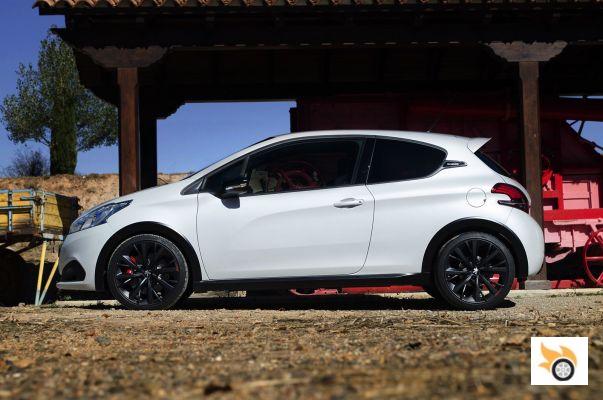
The 208 was, for me, the reunion of Peugeot with a typically feline and French forms, but evolved towards the present times, without sinning in the baroque excess of the 207. The original GTi variant was not too far removed from the "normal" 208, but added enough ingredients to round out the mix. Now, with the restyling of a few months ago, the new rear lights with "light tubes" for the position function, as well as other new small details in the shape of the bumpers, complete an aesthetic that is attractive to almost any taste.
The GTi by Peugeot Sport (PS from now on, to save letters) has subtle but noticeable external aesthetic differences. For starters, the test unit with its pearly white color integrates black plastic wheel arches, powerfully reminiscent of the original 205 GTi. They are joined by a black plastic skirts also that, although in photo give the feeling of increasing ground clearance, live, in person, feel great.
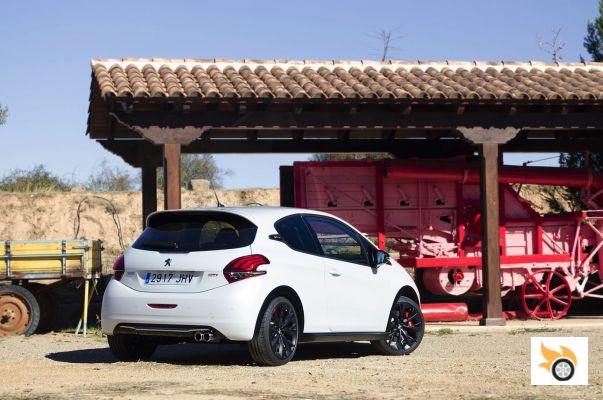
The rear gets two round exhaust tails that remind me of those of my beloved and always missed 206 RC, while the matte black wheels give a "badass" look to the car, which also has more track width in the front and rear (22 millimeters), which helps to visually settle the car better on the asphalt.
However, in my opinion the pearly white color looks great, better than the black and red bicolor, as it allows to show off the work of a very careful bodywork in the consistency of distance between panels. The integration of the headlights in the bodywork is also very well worked, aspects that were not so bright in the French firm before but, as I said the other day with the 308, now are noticed for good.
Cabin
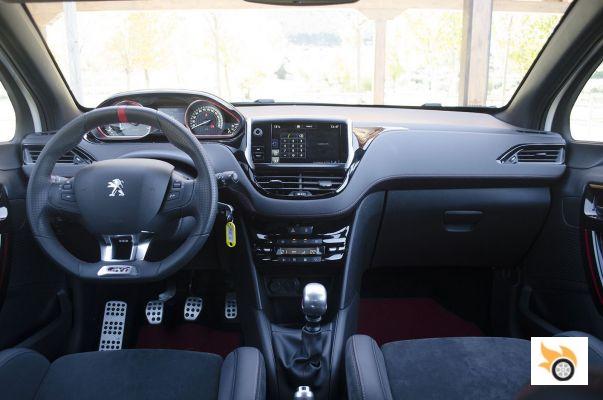
The new features compared to the "normal" 208 GTi when you open the door are already noticeable. The seats are reclining bucket seats with integrated headrest reminiscent of those used in the RCZ-R and the... 206 RC, yes, again. They grip like a dream, and they're not too high either.
The steering wheel has a red strip to remind you where the centre dead centre is, while the rest of the interior gets touches of red in decorative lines and stitching on the leather-covered dashboard.
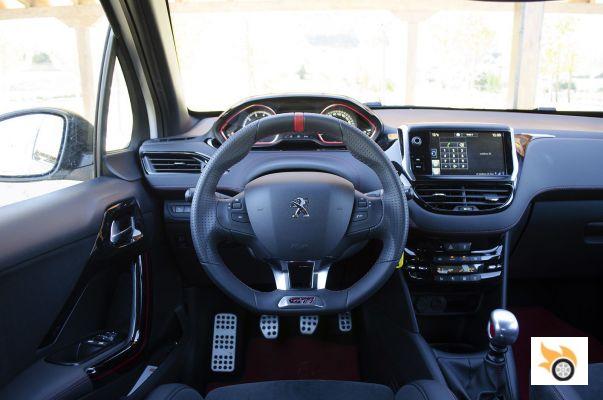
The quirky layout of the 208 once again reminds us that Peugeots are now special. And again I have to break a lance in favor of the French, because the driving position is great, very inspiring rally, although the pedal, with the brake very high relative to the accelerator, makes it very difficult to execute the tip-heel maneuver.
The space in the rear seats is sufficient, despite using the aforementioned trunks, of course these cover a lot of visibility to passengers who may be in the rear seats.
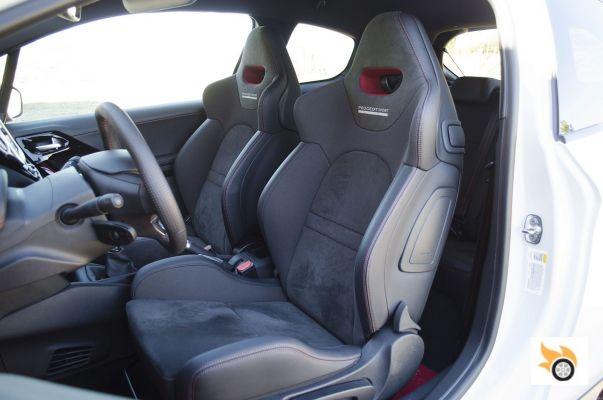
There are details, such as the old cruise control knob, which seem taken from another era, but otherwise, the car is among the best in segment B for quality, finish and ergonomics. There may be those who praise the Polo in general, and the GTI in particular, saying it is a car "better finished" than its rivals, but as I have been arguing since I rode in a 208 of these for the first time, this car mixes its own design and different, character, and finished touches that have little or nothing to envy, if we forget the only point that would change: the buttons on the multifunction steering wheel.
Technique
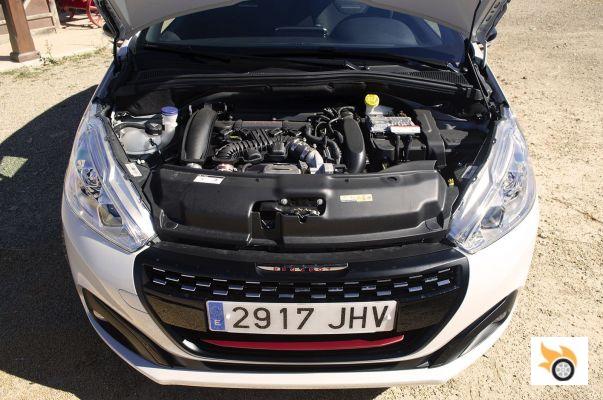
The technique is a direct translation of what was learned in the 208 GTi 30 anniversary. The 1.6-litre THP petrol engine, with direct injection and twin-scroll turbocharger, delivers 208 hp at 5,800 rpm (no coincidence) and 300 Nm of torque from 1,700 rpm. Variable valve timing helps the engine's rpm range to 4,100 revs per minute! This is important to keep in mind, because it is what marks the response of an endless engine... simply great, from the bottom to the top.
The homologated average fuel consumption is 5.4 litres (we'll see later how this isn't feasible in reality), while the transmission is a six-speed manual gearbox, with a Torsen differential with helical gears to avoid unwanted slipping of the front tyres, improve traction and... completely modify the way the 208 bites the corners of the curves.
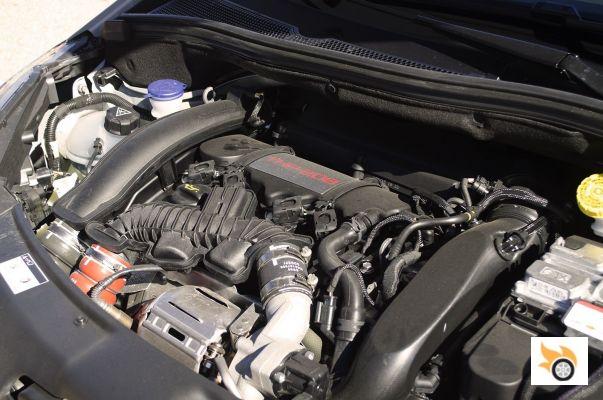
The suspension is a McPherson strut at the front with a rear axle of wheels connected by a single transverse torsional element, supported by springs and shock absorbers. As I said above, geometry and track width are more generous, to help stick the wheels to the ground better. Contact offered by a great Michelin Pilot Super Sport in measure 205/40 R18.
The braking system receives a semi-rigid calipers signed by Brembo with four pistons biting rigid discs (not floating) of 323 millimeters in the front, while the rear is content with solid discs of 249 mm as support.
The steering rack is new, more direct (from 16.5 degrees of steering wheel turn per degree of wheel spin to 16.1 degrees of steering wheel turn per degree of wheel spin), with the dubious electric assist remaining (more on that below).
At a total weight of 1,260 kilograms it's no featherweight, but it has six kilograms per horsepower weight-to-power ratio, which already promises good performance.
Driving
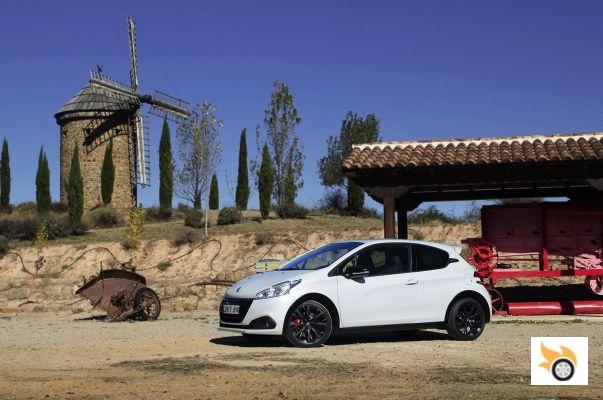
Turn the key in the ignition and start. The sound of the engine is beautiful. It's dominated by the exhaust, which is deep and deep. Two hits of the throttle demonstrate the clear throat of this aluminium block that we've seen so many times before in other PSA models (and MINI).
The clutch is smooth, so smooth that you forget you're in a serious performance car. First gear selected, and you remember the huge step forward in quality gear selection that Peugeot has had. Gone is the imprecise lever with play of the 206 RC and 207. Its doughy feel has given way to a fairly crisp and metallic box in its interlocks.
Driving quietly while the engine warms up (yes, there is a coolant temperature needle!) you discover a suspension that has been thoroughly hardened for this Peugeot Sport, to the point that the half-wits who buy a GTi to show off, and not in search of driving ecstasy, will end up complaining that it is a bit dry. And the fact is that you have to be careful when going over bumps if you don't want your kidneys to suffer. All for the cornering behavior that will then give us.
But beyond this drawback, the steering is smooth, the engine is extremely progressive and powerful from below, and the brakes are perfectly adjustable so you can go shopping, take the kids to school or go to work. That's the great thing about this generation of GTi's, that with all the power they have, they can be tamed to be unique cars that you can live with on a daily basis. And what's even more impressive: in this kind of use, the GTi PS makes do with six and a half litres per 100 kilometres of 95 petrol. And then there are those who buy a diesel...
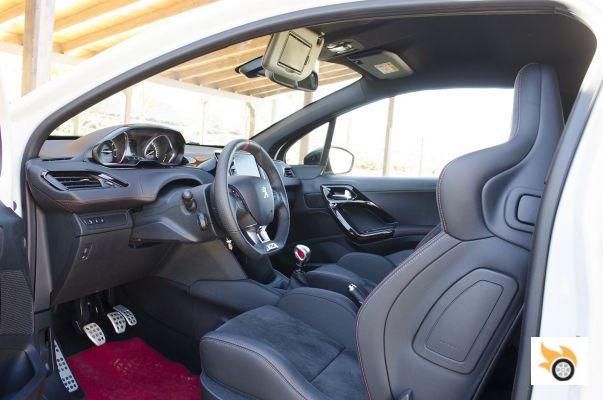
If you're going on holiday or on a weekend getaway, or simply have to go out on the open road for work, the car's comfort, suspension dryness aside, proves more than adequate once again. The engine is a delight, but the exhaust note is too much present at 120 km / h maintained on the highway, especially if it bites a little up the slope, which creates a buzz clearly superior to the normal GTi, constituting the second toll to pay for ... for what will come when you get to the curves.
If you have to overtake trucks in a row on a single-lane country road, 80-120 in under four seconds (we clocked it at 3.9) will leave you stumped. But the best part isn't just the incredible mid-range punch, it's the torque delivery across the entire rev counter spectrum. The engine lacks a marked lag, once you have it spinning above 1,700 turns, has a forceful but linear thrust, without concentrated kick, a progressive and very powerful thrust to the cut, allowing you to complete overtaking and incorporations with a sense of power and security that has no other car in this segment, if we exclude the new MINI JCW, to be much (but much) more expensive.
And then there's the handling on the attack. It's been a long time since I've had a car in my hands that made me get up early in the morning and want to go and enjoy the mountain curves at the weekend. Driving for the sake of driving with no other destination than pure personal enjoyment. This 208 GTi PS has been one of those rarities increasingly difficult to find.
The punchiness of the engine that we mentioned is only magnified when you're looking for the tickle. It may only be 208 horsepower, and in a world where 300 horsepower is "normal" for a compact car, it may not seem like much, but believe me, if you have a curvy road at hand, the 208's torque and power will be more than enough, although we always look for something more due to professional deformation.
Facing my mini-Nürburgring in La Rioja that I'll miss so much once I complete my move to Madrid (I'll just have to revisit it from time to time...), the 208 accelerates without fatigue as I head to my first set of combined downhill curves, the first right, braking, to face a very round left, which closes at the end, much slower than the previous one.
The operation starts coming in fifth gear fast, gaining speed, and consists of first braking straight ahead, and going into the steering wheel while still decelerating to brake harder at the end before changing the support to left, with a tenth of a second of straight steering wheel, which is when you really have to subtract kinetic energy to reduce to second and face the curve, which comes out strong once you see the exit, but with the car very supported, which also allows to assess the motricity.
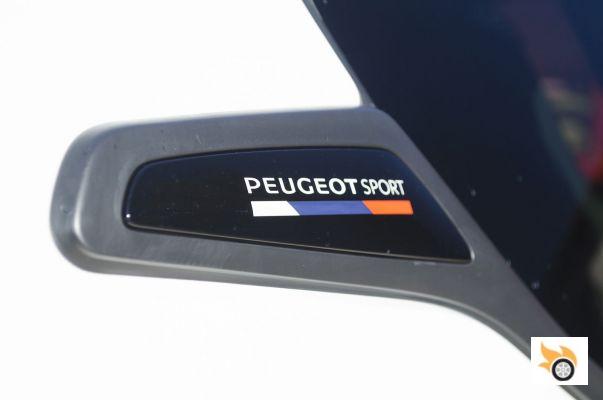
The Brembo are great. From the first stroke of the middle pedal you start to feel, without dead travel, how the discs bite decisively, giving you clear information to modulate them. I loosen the brakes a bit to release the front to face the first curve, while I look for the reduction of two gears to get to third playing with the right ankle. The problem is that the brakes are so powerful and mixed with a central pedal too high, which makes the heel toe unnatural, too complicated... Maybe with a couple of thousand kilometers more with the car I would have achieved a valid technique for it, but it wasn't the case.
With two gears removed, the car rests on deceleration with decision. It doesn't bite, but it doesn't shimmy either. The rear, which in such a delicate moment as that you want to follow what the front wheels do, does just what you ask it to do. The nose is faithfully and precisely set where the steering wheel marks it, with the only downside being that the power steering is too... power steering, if you want to be redundant, and it barely informs the palms of your hands about the effort being made by the Pilot Super Sport, which, by the way, requires two or three hard turns before it warms up and grips "to death".
The change of support is fleeting. The nose inscribes much better than in the normal GTi, and the car changes support, thanks to its thicker stabilizers, without swaying or appreciable inertia, while I pull the brake a little more.
The left-hand corner no longer requires you to go on the brake, but allows you to switch to the accelerator to maintain speed before pushing the pedal to the floor to get out like a shot.
This allows me to glimpse two things. Firstly, the sensitivity of the self-locking differential, which prevents the nose from understeering. If you need to close the line before reaching the apex and play with the inertia, even the rear end is encouraged to show itself. Otherwise, the car is tremendously neutral, easy and predictable to go where you mark it.
Once past the apex and you feel like accelerating, you can anticipate the right pedal to the floor, because the Torsen works its magic. As in any front-wheel drive car of this type, giving full throttle and without contemplation makes the car stick closer to the corner. Certainly you have to execute a certain degree of "over-driving", holding the rim tightly to steer the machine with precision, although there is no pronounced "torque-steer" (parasitic effect on the steering wheel of the self-locking device).
To get the most out of this technique, you have to mentally convince yourself that you can get on the gas much sooner and much more forcefully than you would with 300 Nm in a conventional front-wheel drive, trusting that the mix of the Torsen, the flat torque curve and the Pilot Super Sport will get you into the corner and accompany you all the way to the exit.
And so I do, knowing what the car is capable of after a period of adaptation beforehand, so I glimpse the exit of the curve like rarely before, at full throttle and with surgical precision. You make the 208 GTi PS go where your mind wants it to go.
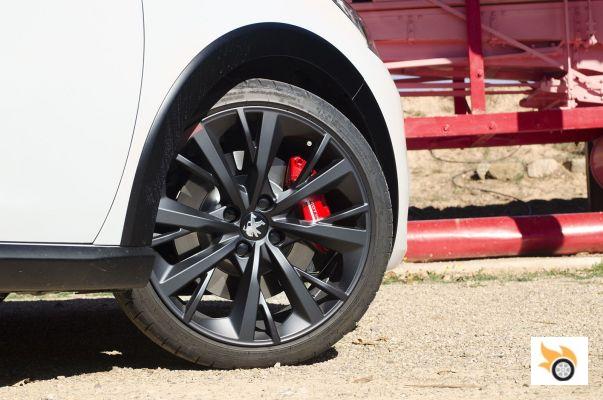
The rest of the cornering is a mere verification of the reality of this GTi: It is a cornering fun machine that gives you immense pleasure. It does have its flaws, of course, as almost any car does. The suspension is very well calibrated. The shock absorber spring commitment is difficult to improve, as often happens with Peugeot almost always, but it is a rigid suspension that if the asphalt is very curly will make the car "crash dryly" against the irregularities, although the good thing is that it does not break the line even with those. That's where the MINI JCW, with its variable suspension in its sportiest mode and its ultra-direct steering, scores a goal in the corner. The 208 GTi PS is more neutral, you can trust it more, it doesn't over-excite you or require you to over-drive it with both hands on the steering wheel and a certain amount of fear. No, the Peugeot is "your friend" and plays with you, it doesn't scare or saturate you. Where the JCW is pure adrenaline, the 208 helps your cause, and makes you smile with pleasure without scaring you. Maybe the fact that it has less horsepower also helps the cause.
But is it the ultimate GTi? This brings up a lot of questions, starting with your personal tastes. No two people in the world are the same, that's for sure. And it all brings us to the Fiesta ST. In a way, it's a conversation you could liken to the one we had with the GT86, with epic differences. The Ford is a car with a livelier rear end and suspension that digests broken tarmac a little better without the dry bounce. The steering speaks to you a hair more. But it's a car that's not as "line-pulling".
To me, call me weird, what I like most about a car is to feel that it works with me. That it goes where I tell it to go. I like the rear wheels with millimetric precision, that enter without nodding, without hesitation, towards the apex when I tell it to. I also like the contribution of the self-locking in front-wheel drive cars, even if they make me work and grip the steering wheel harder, because they allow me to correct the behaviour of the front axle with my right foot during acceleration, by opening or closing the throttle while I precisely delineate the line with the steering wheel. The agile rear? Well, it comes in handy when you're in the second phase of the corner, after the initial braking, when you're travelling towards the apex maintaining speed with the throttle and you want to get a little tighter because you're going long. I like to be able to correct there, and the 208, if you manage its inertias well, even lets you do it, but not as wild as you can be with a Fiesta ST, which is able to "lift the leg", the inside rear wheel into the corner, and mark thirty degrees of oversteer. But that can be exaggerated, depending on whether you're a "barbaric" driver or a "precise" driver. I'm one of the latter, but I understand that there are many people who have more fun with the first technique, which on the other hand is much more dangerous and complicated to practice on the open road, as well as slower and less effective.
So the issue of correctable rear I will say that it is not the Achilles tendon of the 208 GTi Peugeot Sport over the Fiesta ST. The only couple of drawbacks may be the feel of the steering, which has too much assistance (in part by the cure in health to filter the parasitic effects of the self-locking) and the brake pedal too high. For the rest, it seems to me a delightful car, one that I would love to have for fun.
Conclusions
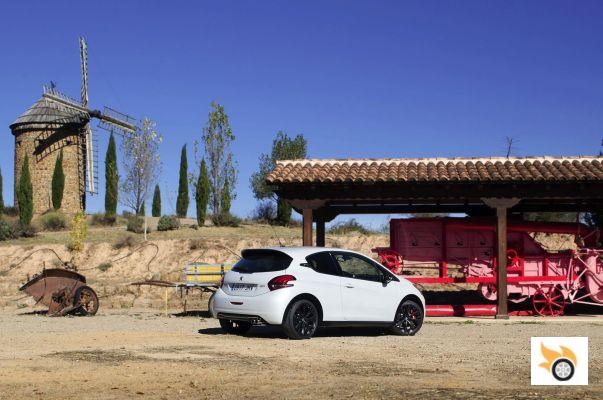
For £26,330 you can buy this Peugeot GTi Sport. Its first rival would be the "normal" 208 GTi, but it's a GT, not a car really aimed at the Pistonudos passionate about enjoying curves, so there, although the PS is more expensive, has the battle completely won.
If you look at the rest of the market, the rivalry is focused exclusively on the Fiesta ST. Why? Because the MINI JCW is much more expensive, while the Cooper S lags behind the GTi. The Polo GTI isn't such a fun or cornering car either, while the new Ibiza Cupra is a bit of an unknown quantity at the moment. Clio RS? It lost its radical edge a long time ago.
Head-to-head with the Ford, the 208 GTi PS is a lot more expensive (almost 5,000 euros), but it's much better equipped, better finished and the interior is of higher quality. The 208's engine is better than the EcoBoost in delivery and consumption, in addition to creating a faster car (four tenths in the 80-120 and almost a second in the 0 to 100), but above all is that progressive, instantaneous and devastating touch from almost idle to the cut.
The Ford has better steering feel and a livelier rear, as I said above, but the driving position and feel of the 208's front end are more appealing.
My personal conclusion? My new favourite B-segment sports car is the 208 GTi Peugeot Sport. Yes, it's an unfinished piece of work, and yes, it could be improved with four well-judged changes, but I can't think of a better car for the same price point in this size.

























